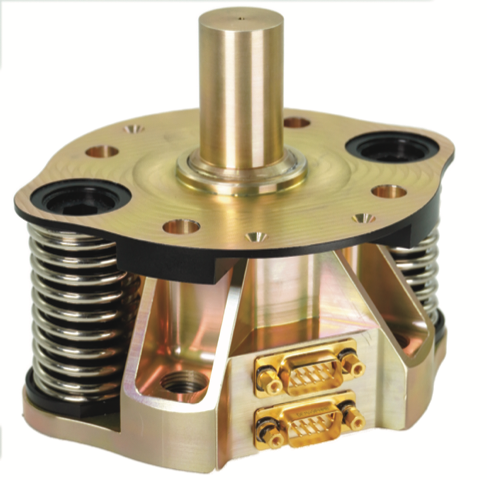Smallsat proliferation requires available, capable and reliable dispensing and separation systems to ensure mission success.

The recent SpaceX Transporter-9 Rideshare mission, for instance, successfully carried 90 payloads, including smallsats, and several orbital transfer vehicles (OTVs) carrying additional spacecraft to be deployed into space at a later time. These were each dispensed from the second stage of Falcon 9 about 55 minutes after takeoff from Vandenberg Space Force Base in California. The entire payload deployment took just over a half an hour to complete.
Achieving the precision and timing of this mission required tapping into the best of today’s space innovation from companies such as Ensign-Bickford Aerospace and Defense (EBAD). As a trusted leader in the space and defense industry, EBAD developed its NEA® Payload Release Modules (PRM) to have advanced to offer fully integrated dispensing and separation capabilities of the spacecraft from the launch vehicle, or OTVs.
The Transporter-9 Rideshare mission used EBAD’s PRM 9103 model as a reliable solution for mounting, retaining, and dispensing of three of the satellites on the mission. EBAD standardized its PRM design to mount directly to the new SpaceX Rideshare Plate, ensuring a seamless and simplified integration with the launch vehicle. This compatibility proved to be a valuable feature for the spacecraft operators and for the successful deployment of its payloads.
The PRM is available in several sizes and is designed for use in a multi-point release system for Smallsats or spacecrafts up to 1200 kg in mass. It uses the flight-proven NEA®HDRM as the primary release mechanism, integrating a load-carrying interface, separation springs, a bolt extractor, and optional separation switch or separation connector to offer a turnkey dispensing mechanism that is ideal for multi-point spacecraft dispensing. In a 4-point mount configuration, the PRM is designed to dispense spacecrafts separating laterally or axially from a central dispensing structure.
EBAD delivers the PRM fully preloaded, and no custom tools or on-site training are required for assembly, making integration into space platforms simple and efficient. Additionally, it is an ultra-low shock, electrically initiated, single-shot (factory refurbishable) release mechanism that has the ability to carry a high tensile preload until commanded to release.
The preload is applied through a release rod held in place by two separable spool halves which are in turn held together by tight winding of restraining wire. The restraint wire is held in place by redundant electrical fuse wires; actuation of either circuit allows release, assuring maximum reliability. When sufficient electrical current is applied, the restraint wire unwinds allowing the spool halves to separate releasing the release rod and the associated preload. The tunable separation springs provide the push-off force to achieve the required separation velocity.

EBAD’s PRM 9103
The PRM 9103 has a location to hold either a telemetry separation switch or a 37-pin separation connector.
The telemetry switch is commonly used to verify spacecraft separation from the launch vehicle, and the separation connector can be used for separation detection, ground power delivery, or communications from the launch vehicle to the spacecraft.
Other key features of the PRM 9103 include ultra-low release shock (less than 500g), redundant actuation circuit, a non-explosive, zero debris Hold Down and Release Mechanism (HDRM) function, a wide operating temperature range, and a high degree of simultaneity between multiple hold-down points.
The PRM 9103 can be operated with standard launch vehicle firing circuitry, has customizable separation velocity, and is qualified to typical launch environments. It is made of space-rated materials with factory refurbishment available.

EBAD has a world-class in-house testing facility that can simulate the extreme conditions of a space launch, including vibrations, temperature changes, and dynamic conditions experienced during ascent. This allows EBAD to test its PRM and other separation mechanisms in an environment that truly replicates space – and to confidently deliver superior solutions for successful missions (with fast turn-around that accommodates expedited launch schedules). Most importantly, this allows EBAD to ensure the safety of each of the multiple payloads involved and help each customer achieve mission success. For EBAD’s customers, this means protecting their investments and reaching their own business goals.
The Transporter 9 mission speaks directly to SpaceX’s ambition to nurture the smallsat market and to provide reliable and safe transport of people and payloads to Earth orbit (and beyond). This is only possible with the support and guidance of dependable partners who are also veterans in serving the space industry.

EBAD is one of those partners dedicated to innovation, problem solving, advancing space exploration and supporting commercial civil and defense space missions. With another successful launch and release in space, EBAD continues to support its customers’ journey to space.
www.ebad.com
Headquartered in Simsbury, Connecticut, with facilities also in Graham, KY., and Moorpark, CA., EBAD has been in business for more than 180 years. EBAD’s satellite HDRM’s mainly used in the U.S. and European space market, have been on more than 500 platforms to date. Through its NEA® and TiNi™ product lines, EBAD has designed, qualified, and delivered more HDRM’s for spaceflight applications than anyone else in the world, with 100 percent mission success over a 20+ year period and nearly ten thousand mechanisms successfully released into space.


